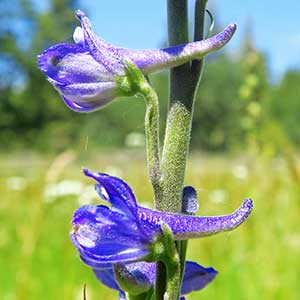Delphinium distichum
Delphinium umbraculorum
Burke's larkspur, meadow larkspur, strict larkspur, two-spike larkspur
umbrella larkspur
(25-)30-60(-80) cm;
base sometimes reddish, puberulent.
40-70(-90) cm;
base often reddish, glabrous or puberulent.
blade cuneate to semicircular, 1-5 × 1.5-7 cm, puberulent; ultimate lobes 5-19, width 2-8(-15) mm (basal), 0.5-3(-5) mm (cauline);
margins of basal leaf, measured less than 1 cm from blade base, demarcating considerably more than 90° of arc when leaf laid flat;
most cauline leaf blades exceeding internodes.
blade round to pentagonal, 1.5-4 × 2-6 cm, nearly glabrous; ultimate lobes 3-13, width 3-20 mm (basal), 1-8 mm (cauline).
8-30(-40)-flowered, usually dense;
pedicel 0.5-1.5 cm, puberulent;
bracteoles 0-3 mm from flowers, green to blue, linear, 4-8 mm, puberulent.
(5-)10-25(-45)-flowered, open, narrowly pyramidal;
pedicel 0.5-3(-7) cm, glabrous to puberulent;
bracteoles 3-7 mm from flowers, green, linear, 3-6 mm, puberulent.
sepals dark blue to bluish purple, puberulent, lateral sepals ± erect, 8-12 × 3.5-5 mm, spurs straight, horizontal or nearly so, 9-15 mm;
lower petal blades ± covering stamens, 4.5-6.5 mm, clefts 2-3 mm;
hairs centered mostly near base of cleft, white.
sepals dark blue, puberulent, lateral sepals spreading, 9-16 × 4-7 mm, spurs gently upcurved, ascending 30-45° above horizontal, 8-14 mm;
lower petal blades elevated, exposing stamens, 3.5-6 mm, clefts 0.5-1.5 mm;
hairs densest near junction of blade and claw above base of cleft, centered or on inner lobes, white.
7-13 mm, 3.5-4 times longer than wide, ± puberulent.
9-16(-19) mm, 2.5-3(-4) times longer than wide, puberulent.
seed coat cells with surfaces roughened.
seed coat cells brick-shaped, cell margins straight, surfaces smooth.
= 16.
= 16.
Delphinium distichum
Delphinium umbraculorum
Delphinium distichum hybridizes with D. multiplex and D. nuttallianum (D. ×diversicolor Rydberg). The name D. burkei has often been misapplied to D. distichum.
(Discussion copyrighted by Flora of North America; reprinted with permission.)
Delphinium umbraculorum is most often confused with D. patens subsp. hepaticoideum; refer to discussion of that taxon for distinguishing features. Hybrids occur with D. parryi and D. patens subsp. montanum.
(Discussion copyrighted by Flora of North America; reprinted with permission.)
- Local floras:
BC,
OR,
WA
- Local Web sites:
Flora NW,
PNW Herbaria
WildflowerSearch
iNaturalist (observations)
USDA Plants Database
- LBJ Wildflower Center
- SEINet
- Plants of the World Online
- Encyclopedia of Life
- Wikipedia
- Google Image Search


